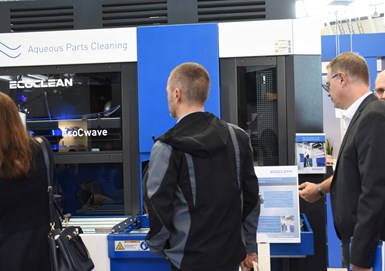parts2clean Trade Show Will Reveal Parts Cleaning Trends
Often, cleaning technologies displayed at this annual show in Germany is a foreshadowing of what the U.S. market will eventually have available to it. Read about the trends predicted at this year’s parts2clean.
Update: Since this article was written, the 2020 parts2clean trade show has been canceled. However, the following information still reflects industry trends especially in the European market.
The effects of the coronavirus pandemic have, in many cases, positively influenced manufacturers across the globe, shedding light on their crucial machining capabilities that are necessary and in high demand, especially those machine shops supplying to the medical industry. Along with machining these critical parts come cleaning them as well.
Management of the parts2clean trade show in Germany recognizes that keeping abreast of the latest cleaning technology and trends is, in some ways, more important now than ever before. Therefore, the largest manufacturing cleaning show in the world must go on! Parts2clean is scheduled for Oct. 27-29, 2020, at the Stuttgart Exhibition Centre.
Although business travel may not be an option for many this year, following up on parts2clean will be interesting to those who cannot attend, since it promises to reveal trends in the cleaning industry.
Olaf Daebler, global director, parts2clean, at Deutsche Messe AG, shares that he realizes some manufacturers have had to adjust their cleaning processes because of the virus. “The flexibilization, virtualization and digitalization of work processes made necessary by the coronavirus is also leading to changes in industrial parts cleaning,” he says. “Many suppliers have been creative in finding solutions in order to eliminate user problems and provide support without having to be on site.”
The international show’s exhibits will feature suppliers from various industry segments that will share their latest technologies and trends with attendees. Product ranges will include equipment for versatile and demanding cleaning tasks in general industry and remanufacturing and for intermediate and final cleaning as well as fully automated cleaning systems for highest demands on cleanliness and flexibility.
For electronic and already assembled parts, there is a trend toward dry cleaning technologies. When it comes to fulfilling high particulate, organic and/or inorganic or biological cleanliness requirements, attendees will see new cleaning and drying processes for wet chemical cleaning, as well as new and optimized alternative cleaning solutions like plasma, laser and CO2 snow-jet cleaning.

The annual parts2clean trade show is on for 2020. Highlights include trending technologies such as dry cleaning and new and optimized alternative cleaning solutions such as plasma, laser and CO2 snow jet cleaning. (Photo courtesy of Stuttgart Exhibition Centre.)
Applications from the semiconductor supply industry, medical technology, optics, precision engineering, sensor and laser technology, and the coating industry will be other focuses. The automotive industry is also in great demand for new cleaning solutions that will be on display at the show.
RELATED CONTENT
-
Ultrasonic Cleaning Basics: Technology, Solvents and Advantages
Ultrasonic cleaning technology is explained here as well as how to choose a type of ultrasonic machine for an application, the kind of detergent to use, and the advantages of using this parts cleaning method.
-
The Importance of Drying Parts After Cleaning
Most cleaning processes consist of three steps, not two: wash, rinse and dry. That drying step is absolutely necessary for everything from product finishing to product performance to effective throughput to product quality.
-
Get to Know Cleanliness Standards
With a small amount of practice, it is possible to understand the underlying motivation of a cleaning standard and to figure out the specific aspects of the specification that are applicable to the customer.
.png;maxWidth=970;quality=90)


